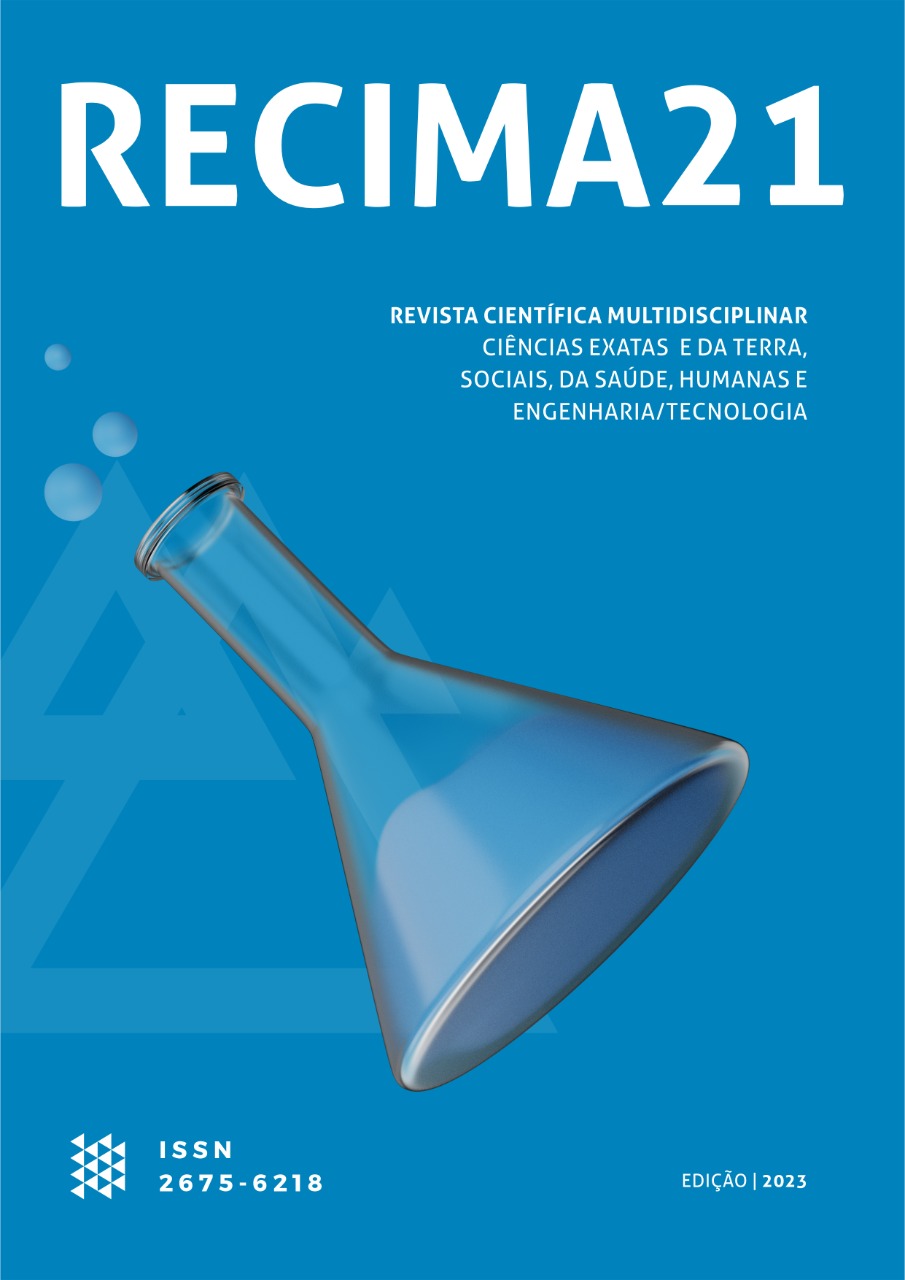EFEITO CARRAPATICIDA IN VITRO DE LUNDIA CORDATA SOBRE RHIPICEPHALUS MICROPLUS
DOI:
https://doi.org/10.47820/recima21.v4i4.3031Palavras-chave:
carrapato, cipó de vaqueiro, extratoResumo
O método mais utilizado no controle do carrapato são os acaricidas sintéticos, que além de deixarem resíduo nos produtos de origem animal, contaminação ambiental, tem levado os carrapatos a desenvolverem mecanismos de resistência. Logo, a utilização de extratos vegetais tem sido considerada uma importante alternativa para o controle desses ectoparasitas. Lundia cordata, uma liana pertencente à família Bignoniaceae, foi testada quanto as suas propriedades acaricidas sobre R. microplus. Foram avaliados os efeitos das concentrações 25, 50 e 100% do extrato hidroalcóolico sobre a eficácia reprodutiva do carrapato. As diferentes concentrações do extrato não determinaram mortalidade de teleóginas, mas o grupo tratado com o extrato a 100% apresentou uma taxa de eclosão de 36%. A eficácia do produto foi de 14,4% na concentração a 25%, 15,5% a 50%, e 69,72% a 100%. Apesar do extrato bruto apresentar um valor na eficácia superior às demais concentrações, ainda é considerada baixa para o controle de carrapatos bovinos. Sugere-se estudos posteriores com o extrato de liana associados a outros produtos vegetais.
Downloads
Referências
ALBUQUERQUE, U. P., MEDEIROS, P. M., ALMEIDA, A.L.S., MONTEIRO, J.M., LINS NETO, E.M.F., MELO, J.G., SANTOS, J.P. Medicinal plants of the caatinga (semi-arid) vegetation of NE Brazil: A quantitative approach. Journal of Ethnopharmacology, v.114, n.3, p.325–354, 2007.
ANDREOTTI, R. Situação atual da resistência do carrapato-do-boi Rhipicephalus (Boophilus) microplus aos acaricidas no Brasil. Campo Grande, MS: Documentos - Embrapa Gado de Corte, 180p, 2010.
BAGAVAN, A., KAMARAJ, C., ELANGO, G., ABDUZ ZAHIR, A., ABDUL RAHUMAN, A. Adulticidal and larvicidal efficacy of some medicinal plant extracts against tick, fluke and mosquitoes. Veterinary Parasitology, v.166, n.3-4, p.286–292, 2009.
BORGES, L.M.F., SOUSA L.A.D., BARBOSA, C.S. Perspectives for the use of plant extracts to control the cattle tick Rhipicephalus (Boophilus) microplus. Revista Brasileira de Parasitologia Veterinária, v.20, n.2, p.89-96, 2011. doi: https://doi.org/10.1590/S1984-29612011000200001
BRASIL. MINISTÉRIO DA AGRICULTURA. Normas para registros de parasiticidas de uso pecuário no Brasil. Brasília: Ministério da Agricultura, 1987.
CASTILLO, L., ROSSINI, C. Bignoniaceae Metabolites as Semiochemicals. Molecules, v.15, n.10, p.7090–7105, 2010. doi: 10.3390/molecules15107090
CHAGAS, A.C.S, PASSOS, E.M., PRATES, H.T., LEITE, R.D.C., FURLONG, J., FORTES, I.C.P. Efeito acaricida de óleos essenciais e concentrados emulsionáveis de Eucalyptus spp em Boophilus microplus. Brazilian Journal of Veterinary Research and Animal Science, v.39, n.5, p.247–253, 2002.
CLEMENTE, M. A.; GOMES, F. T.; SCOTTON, A. C. B. S.; GOLDNER, M. S.; REIS, E. S., ALMEIDA, M. N. Avaliação do Potencial de Plantas Medicinais no Controle de Boophilus microplus (Acari: Ixodidae). Revista Brasileira de Biociências, v.5, n.2, p.516-518, 2007.
COSTA-JÚNIOR, L.M.; MOLEIRO, R. J.; ALVES, P. B.; BLANK, A. F; LI, A. Y., LEÓN, A. A. P. Acaricidal effecacies of Lippia gracilis essential oil its phytochemicals Against organophosphorate-resistant and susceptible strains of Rhipicephalus (Boophilus) microplus. Veterinary Parasitology, v.228, p.60-64, 2016. doi: 10.1016/j.vetpar.2016.05.028.
CRUZ, E.M.O., COSTA JR, L.M., PINTO, J. A., SANTOS, D. DE A., DE ARAUJO, S. A., ARRIGONI-BLANK, M. DE F., BACCI, L., ALVES, P. B., CAVALCANTI, S. C., BLANK, A.F. Acaricidal activity of Lippia gracilis essential oil and its major constituents on the tick Rhipicephalus (Boophilus) microplus. Veterinary Parasitology, v.195, n.1-2, p.198–202, 2013). doi: https://doi.org/10.1016/j.vetpar.2012.12.046
DRUMMOND, R. O.; ERNEST, S. E.; TREVINO, J. L.; GLADNEY, W. J., GRAHAM, O. H. Boophilus annulatus and B. microplus: laboratory tests of insecticides. Journal of Economic Entomology, v.66, n.1, p.130-133, 1973. doi: 10.1093/jee/66.1.130.
DUARTE, M. C. T.. Atividade Antimicrobiana de Plantas Medicinais e Aromáticas Utilizadas no Brasil. Multi ciência, Campinas, SP, 2006.
FREITAS, D.R.J., POHL, P.C., VAZ JR., I. DA S. Caracterização da resistência para acaricidas no carrapato Boophilus microplus. Acta Scientiae Veterinariae, v.33, n.2, p.109–117, 2018. doi: https://doi.org/10.22456/1679-9216.14778
GRISSI, L., MASSARD, C.L., MOYA, B.G.E., PEREIRA, J.B.. Impacto econômico das principais ectoparasitoses em bovinos no Brasil. A Hora Veterinária, v.21, n.125, p.8–10, 2002.
GOBBO-NETO, L., LOPES, N. P. Plantas Medicinais: Fatores de Influência do Conteúdo de Metabólitos Secundários. Química Nova, v.30, n.2, p.374-381, 2007. doi: 10.1590/S0100-40422007000200026.
GHOSH, S., TIWARI, S. S., SRIVASTAVA, S., SHARMA, A. K., KUMAR, S., RAY, D. D., RAWAT, A. K. Acaricidal properties of Ricinus communis leaf extracts against organophosphate and pyrethroids resistant Rhipicephalus (Boophilus) microplus. Veterinary Parasitology, v.192, n.1-3, p.259– 267, 2013. doi: 10.1016/j.vetpar.2012.09.031
GUERREIRO, F. D.; LOVIS, L., MARTINS, J. R. Acaricide resistance mechanisms in Rhipicephalus (Boophilus) microplus. Revista Brasileira de Parasitologia Veterinária, v.21, n.1, p.1-6, 2012. doi: 1 0.1590/S1984-29612012000100002.
HEIMERDINGER, A.; OLIVO, C.J.; MOLENTO, M.B.; AGNOLIM, C.A.; ZIECH, M.F.; SCARAVELLI, L.F.B.; SKONIESKI, F.R.; BOTH, J.F.; CHARÃO, P.S. Extrato alcóolico de capim-cidreira (Cymbopogon citratus) no controle do Boophilus microplus em bovinos. Revista Brasileira de Parasitologia Veterinária, v.15, n.1, p.37-39, 2006.
JULIET, S.; RAVINDRANB, R.; RAMANKUTTYB, S. A.; GOPALANB, A. K. K.; NAIRA, S. N.; KAVILLIMAKKILB, A. K.; BANDYOPADHAYAYC, A.; RAWTD, A. K. S., GHOSHE, S.. Jatropha curcas (Linn) leaf extract – a possible alternative for population control of Rhipicephalus (Boophilus) annulatus. Asian Pacific Journal of Tropical Disesase, v.2, n.3, p.225-229, 2012. doi: 10.1016/S2222-1808(12)60051-6.
LÁZARO, S. F., FONSECA, L. D., MARTINS, E. R., DE OLIVEIRA, N. J., DUARTE, E. R.. Effect of aqueous extracts of Baccharis trimera on development and hatching of Rhipicephalus microplus (Acaridae) eggs. Veterinary Parasitology, v.194, n.1, p.79– 82, 2013. doi: 10.1016/j.vetpar.2012.12.025
MEKONNEN, S., BRYSON, N.R., FOURIE, L. J., PETER, R.J., SPICKETP, A.M., TAYLOR, R.J., STRYDOM, T., HORAK, I.G. Acaricide resistance profiles of single- and multi-host ticks from communal and commercial farming areas in the Eastern Cape and North-West Provinces of South Africa. The Onderstepoort Journal of Veterinary Research, v.69, n.2, p.99–105, 2002.
PEREIRA, M. C.; LABRUNA, M. B.; SZABÓ, M. P. J.,KLAFKE, G. M.. Rhipicephalus (Boophilus) microplus Biologia, Controle e Resistência. São Paulo: MedVet, 2008.
RAVINDRAN, R., JULIET, S., SUNIL, A. R., KUMAR, K. G., NAIR, S. N., AMITHAMOL, K. K., SHYNU, M, RAWAT, A. K., GHOSH, S. Eclosion blocking effect of ethanolic extract of Leucas aspera (Lamiace.ae) on Rhipicephalus (Boophilus) annulatus. Veterinary Parasitology, v.179, n.1-3, p.287–290, 2011. doi: 10.1016/j.vetpar.2011.02.021
RIBEIRO, V. L., DOS SANTOS, J. C., MARTINS, J. R., SCHRIPSEMA, J., SIQUEIRA, I. R., VON POSER, G. L., APEL, M. A. Acaricidal properties of the essential oil and precocene II obtained from Calea serrata (Asteraceae) on the cattle tick Rhipicephalus (Boophilus) microplus (Acari: Ixodidae). Veterinary Parasitology, v.179, n.1-3, p.195–198, 2011. doi: 10.1016/j.vetpar.2011.02.006
RODRIGUES, S.; RODRIGUES, M., CRUZ, C.. The acaricide effect of Ethanolic Extracts of Some Plants on Tics Rhipicephalus (Boophilus) microplus. La Revista MVZ Córdoba, v.15, n.3, p.2175- 2184, 2010.
SANTOS, I.A.P., CARVALHO, C.M., SANT’ANA, A.E.G., LUNA, J.S. Avaliação do potencial carrapaticida de espécies Vegetais do Nordeste Brasileiro, 2014
SANTOS, B. M.; BRUNO FILHO, F. B., MENDES, M. M.. Avaliação da ação de extratos vegetais com potencial atividade carrapaticida. PUBVET, v.12, n.8, p.1-7, 2018. doi: 10.31533/pubvet.v12n8a157.1-7.
SILVA FILHO, M.L., SILVA, L.B., FERNANDES, R.M., LOPES, G.S. Efeito do extrato aquoso e etanólico do angico preto sobre larvas de Rhipicephalus (Boophilus) microplus. Arquivo Brasileiro de Medicina Veterinária e Zootecnia, v.65, n.3, p.637-644, 2013.
SOARES, S.F., BRAGA, R.S., FERREIRA, L.L., LOULY, C.C.B., SOUSA, L.A.D., SILVA, A.C., BORGES, L.M.F. Repellent activity of DEET against Amblyomma cajennense (Acari: Ixodidae) nymphs submitted to different laboratory bioassays. Revista Brasileira de Parasitologia Veterinária, v.19, n.1, p.12-16, 2010. doi:https://doi.org/10.4322/rbpv.01901003
TURATO, E. R. Métodos qualitativos e quantitativos na área da saúde: definições, diferenças e seus objetos de pesquisa. Revista de Saúde Pública, v.39, n.3, p.507-514, 2005.
WIGGERS, I., STANGE, C. E. B. Manual de instrução para coleta, identificação e herborização de material botânico. Laranjeiras do Sul, PR, 2008.
Downloads
Publicado
Edição
Seção
Categorias
Licença
Copyright (c) 2023 RECIMA21 - Revista Científica Multidisciplinar - ISSN 2675-6218

Este trabalho está licenciado sob uma licença Creative Commons Attribution 4.0 International License.
Os direitos autorais dos artigos/resenhas/TCCs publicados pertecem à revista RECIMA21, e seguem o padrão Creative Commons (CC BY 4.0), permitindo a cópia ou reprodução, desde que cite a fonte e respeite os direitos dos autores e contenham menção aos mesmos nos créditos. Toda e qualquer obra publicada na revista, seu conteúdo é de responsabilidade dos autores, cabendo a RECIMA21 apenas ser o veículo de divulgação, seguindo os padrões nacionais e internacionais de publicação.













